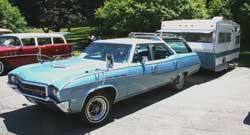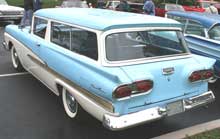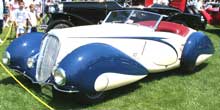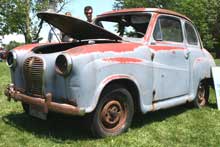Circle the Wagons
Shortly after I posted last week's CarPort about two-door station wagons, I became aware that the International Station Wagon Club was holding its national meet at the historic Publick House in Sturbridge, Massachusetts, not far from where I live. Coincidence or not, it seemed like an opportunity not to be missed, so I didn't miss it.
The age of wagons stretched from brass Model T to some time last week, and class judging was arranged for Original Unrestored wagons, Original Restored (how can it be original if it's been restored?), Modified and Returning Champions. There were woodie favorites like a 1940 Pontiac, a '50 Buick Super and an exquisite 1933 Ford with a complete set of original tools. The faux wood brigade included a '53 Country Squire, '65 ditto, a pair of 1969 Chrysler Town and Country wagons and a seldom-seen 1966 Mercury Comet Villager. Next to the Comet was an equally noteworthy 1959 Plymouth Suburban and not far away a 1962 Corvair Lakewood. The '64 Ford Fairlane was billed as a Custom Ranch Wagon, and was nostalgic to me for its 260 cid V8, just like the one in our old '63 Falcon.
The only hardtop wagon was a '57 Mercury four-door Commuter in drive-in theater trim. From Stratford, Connecticut came a '64 Ford patrol car, and the '59 Rambler reminded me of one my next-door neighbor used to have. A '65 Rambler 660 basked in the champions' circle, a bare-bones model with few accessories. American Motors, ever pragmatic, put its unused shift quadrant to good purpose The ISWC welcomes wagons to come as they are, good for this 1963 Dodge, and embraces such youngsters as a '99 Mercury Sable, late model Buick Roadmaster and a Pontiac 6000. Apart from a 2000 Mercedes-Benz E320, the only import was a '58 Hillman Estate Wagon (but, sadly, not a single Husky). Thankfully, people are starting to collect Plymouth Volares, particularly the Premier Edition.
Big wagons demand big engines, and there were many on hand. The '57 Chrysler New Yorker had a hemi, of course, and there were both 427 and 454 Chevrolets, the latter having spells of incontinence. The largest Ford engine seemed to be a 352.
A theme meet calls for theme-appropriate accessories, and station wagons provide ideal places to display them. If there was a disappointment it was finding only three two-door wagons. A '57 Pontiac Safari contrasted with Chevy's '57 Bel Air Handyman with the "conventional" tail, though the latter was a bit overdone for my taste. Steve Mierz took me to task last week for forgetting his wife Diane's 1973 Pinto Squire,which made its CarPort debut last year. The ISWC show rubbed it in with a 1977 version of the same car. The Pontiac Safari is so well known that we forget that the name survived much longer on big four-door Ponchos.
Among the station wagon owners and spectators were rapaciously writing reporters, and furiously focusing photographers. You'll probably see their coverage in the mainstream media. My favorite outfit was the 1969 Buick Sportwagon, which was hitched to a matching '69 Shasta Loflyte camper. The weather was perfect and I was glad to see people preserving cars that are a bit out of the ordinary. As a parting exercise, consider this plaintive face. Tell us what you think it is.




